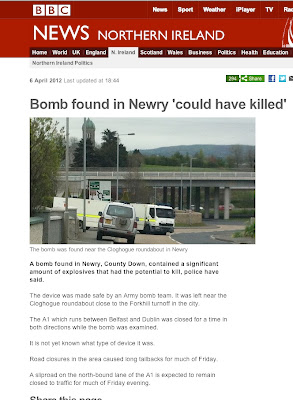 |
| Columbia, left, fends off a challenge from the Shamrock in 1899, first of many successive Irish bids for the America's Cup |
My great-grandfather was a newsman from the tips of his toes
to the brim of the felt hat on which he practised his shorthand during the sermon while in
church. One hundred years ago today, 10 April 1912, he had to make a choice
between two stories.
One was a chance to go on board the Shamrock III, a racing
yacht that was then the latest in a series of five challenging for the most
prestigious prize of all, the America’s Cup.
The alternative story was to go out on a tender to the
latest in a series of ocean liners plying the north Atlantic route. That seemed
a mundane assignment compared to the chance of skimming the waters of Cork
Harbour in a sleek vessel owned by the tea millionaire, Sir Thomas Lipton.
My great-grandfather Michael Bowen made his choice. Sure he
could always go on board the Titanic when it called back on its return voyage!
A century later, it seems like the greatest mistake one
could possibly make in a journalistic career. Yet by contemporary standards, he
made the correct choice. Any seasoned reporter covering maritime affairs for
the Cork Examiner, as well as the Daily Mail and its sister newspapers in
London, would have had little hesitation in going for the chance to sail in the
Shamrock III.
Sir Thomas Lipton (1848-1931, had been born in Glasgow to
parents who had emigrated from the Clones area of County Fermanagh. From
exceptionally humble beginnings, he went to sea as a cabin boy and embarked on
a remarkable business career, soon becoming a self-made millionaire.
Yet Lipton was also renowned as ‘the most persistent
challenger in the history of the America’s Cup’ and his yachts flew the flag
for Ireland with the Royal Ulster Yacht Club in every successive challenge for
the prize between 1899 and 1930. This was the only time in history that Ireland
was the exclusive challenger for the ornate silver jug trophy.
 |
| Self-made millionaire Sir Thomas Lipton. |
In 1899, Lipton provided the finance for the William
Fife-designed yacht, Shamrock. While it failed against Columbia, owned by the
Pierpont-Morgan syndicate from the United States, Lipton was a mastermind of
publicity. He raised the America’s Cup event to rapturous international appeal.
This also boosted Lipton’s tea on a market surge that was considerably more
successful than the ocean race bids.
Lipton was back in 1901 with Shamrock II, again pipped by
the Columbia. Undaunted, he and the Royal Ulster Yacht Club challenged the Reliance,
owned by the Vanderbilts, in 1903. This time it was the Shamrock III that
carried the flag and the hope.
It was that sleek vessel that my great-grandfather boarded a
hundred years ago today at Queenstown for a once-in-a-lifetime story. One
suspects that as they plied the waves, he just gave passing attention to the
big ship lying off the mouth of the harbour beyond. It was no more than a date
for his dairy if it did not have that fateful rendezvous with an iceberg in its
own race for glory through treacherous ocean waters.
The Titanic was lost, of course, and Sir Thomas Lipton
failed in his further challenges for the America’s Cup with Shamrock IV and
Shamrock V in 1920 and 1930.
Yet
the publicity of his challenges propelled his tea brand to the premier spot in
the American market.
As for my great grandfather, three years after the Titanic, a
chance remark that the tenders had gone out from one of my grand-aunts
returning from school alerted him to a possible story. Michael Bowen rushed
down to the harbour office and managed to get on board another boat setting out
for the Old Head of Kinsale.
When he returned with survivors a few hours later,
he immediately filed a story to London.
 |
| The Lusitania was torpedoed off the Old Head of Kinsale. |
The Evening Standard ran a special late edition on 5 May
1915 announcing the ‘Sinking of the Lusitania’scooping every other news organisation by a full day on the biggest story of the era in terms of its consequences.
Of the 1,959 on board, 1,198 perished when a German U-boat
torpedoed the Lusitania as it approached the mouth of Cork Harbour. The huge loss of lives, including many Americans on board, caused outrage and
convinced the United States to enter the First World War and help defeat Germany.
And my great-grandfather? He got a bonus and a handshake
from Lord Northcliffe and spent the closing years of his journalism career
plying between his home in Queenstown (soon to be renamed Cobh) and Southampton
and Cherbourg while filing stories of the great ocean liners and the VIPs on
board.
Yet I bet Michael Bowen would have traded all that to see Thomas
Lipton lift the America’s Cup for the Royal Ulster Yacht Club with an Irish victory
for one of the Shamrocks.



